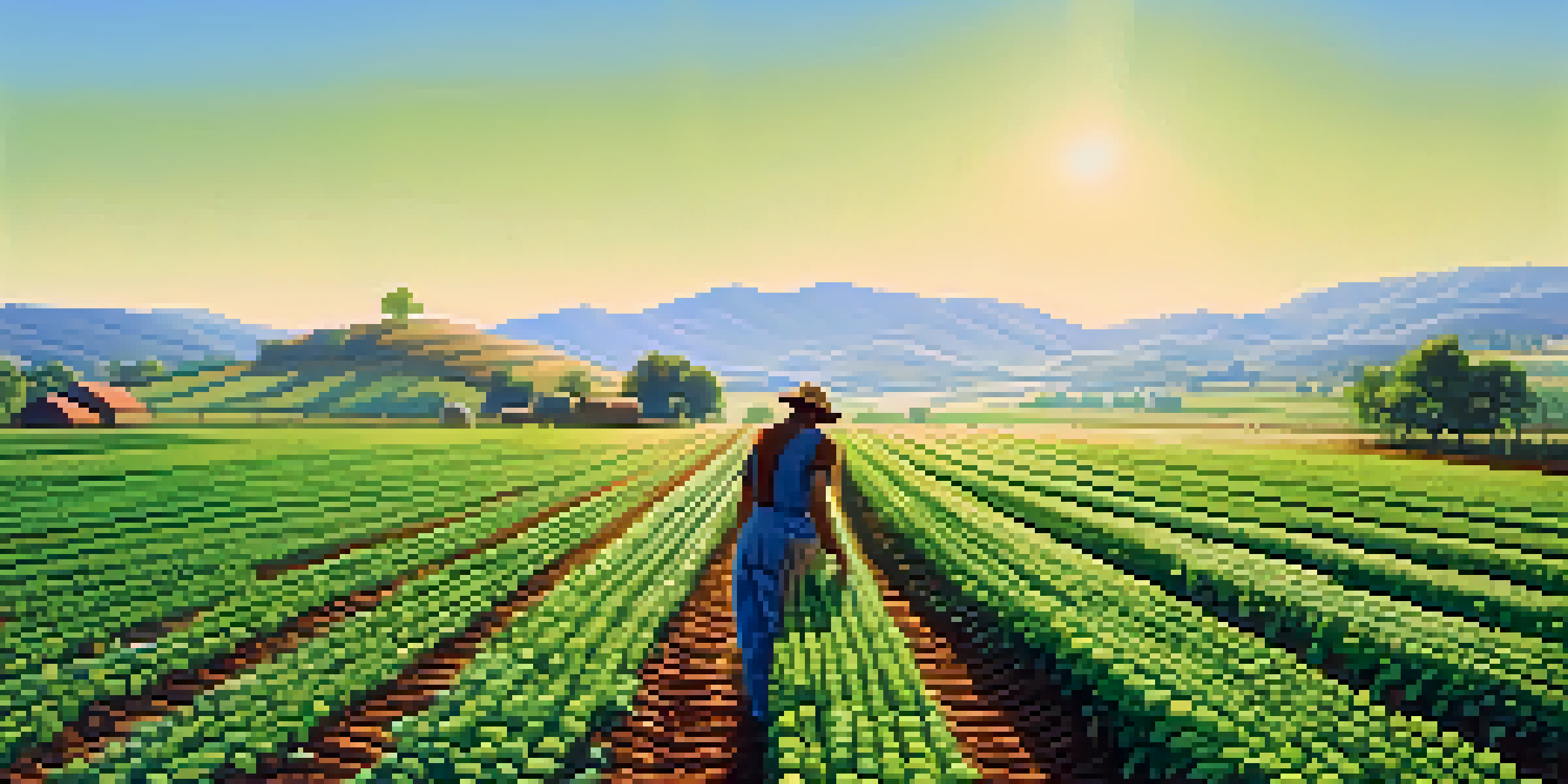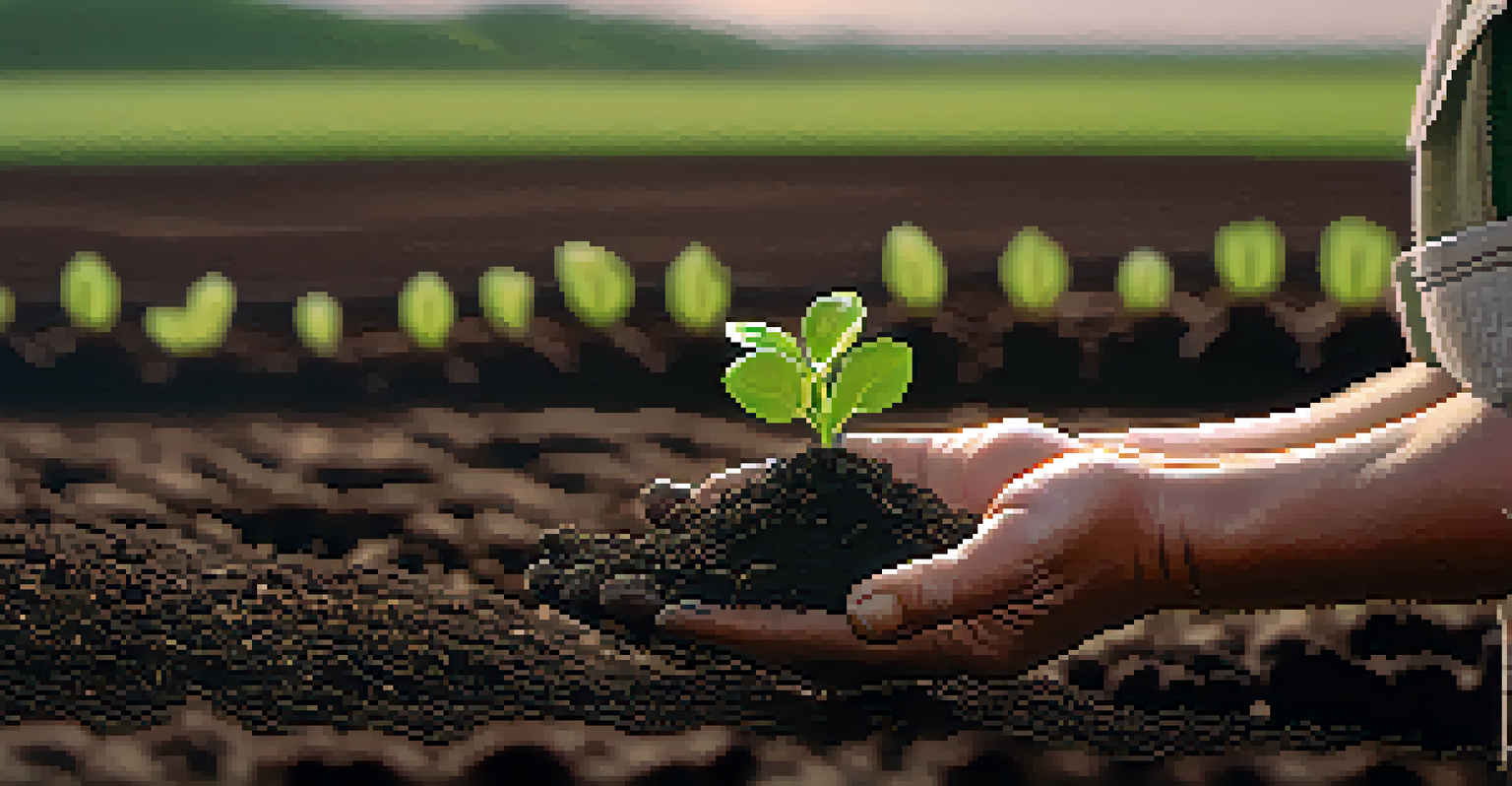Plants in Agriculture: Economic Factors and Global Trade

The Role of Plants in Agriculture's Economic Landscape
Plants are the backbone of agriculture, providing food, fiber, and raw materials. They not only support livelihoods but also contribute significantly to national economies. For instance, crops like wheat and corn are staples that impact food security and trade balances across countries.
Agriculture is the most healthful, the most useful and the most noble employment of man.
The economic significance of plants extends beyond local farms; it influences global markets. When a country produces a surplus of a crop, it can export, creating jobs and boosting income. Conversely, a poor harvest can lead to increased prices and economic strain, highlighting the delicate balance of agricultural economies.
Moreover, the demand for various plant products encourages innovation in farming practices and technology. From genetically modified organisms (GMOs) to organic farming, these advancements aim to increase yield and sustainability, ultimately affecting economic growth in agriculture.
Global Trade: How Plants Fuel International Commerce
Global trade in agricultural products is a multi-billion dollar industry, with plants at its core. Countries engage in trade not just for food but also for raw materials like cotton and rubber, which are vital for various industries. For example, the trade of soybeans has skyrocketed, driven by demand from countries like China.

Trade agreements often hinge on agricultural products, showcasing their importance in diplomatic relations. When countries negotiate trade deals, plant products frequently take center stage, as they can make or break economies. This interconnectedness emphasizes how much plants influence global commerce.
Plants Drive Economic Growth
Plants are crucial for agriculture, impacting food security, job creation, and national economies.
Additionally, fluctuations in trade policies, tariffs, and regulations can significantly impact the agricultural sector. For instance, a sudden tariff on imported fruits can lead to price hikes domestically, affecting consumers and farmers alike. Understanding these dynamics is essential for grasping the full picture of global agricultural trade.
Economic Factors Influencing Plant Production
Several economic factors play a crucial role in determining plant production levels. Climate conditions, soil health, and labor availability are fundamental aspects that farmers must consider. For example, drought can severely limit crop yields, while a well-trained workforce can enhance productivity.
The future of food is not a single solution; it’s a complex web of technology, sustainability, and consumer demand.
Market demand also drives production decisions. If consumers shift towards plant-based diets, farmers may pivot to growing more fruits and vegetables, impacting the overall economy. This trend reflects broader societal changes that can ripple through agricultural markets.
Furthermore, government policies and subsidies can influence what crops are planted. For instance, subsidies for corn production in the United States have historically led to an oversupply, affecting prices and farmer incomes. Thus, understanding these economic factors is critical for stakeholders in the agricultural sector.
The Impact of Climate Change on Agriculture
Climate change poses significant challenges to agriculture and plant production. Rising temperatures, altered rainfall patterns, and extreme weather events can disrupt traditional farming practices. For instance, farmers in drought-prone regions may struggle to maintain yields, impacting both local and global food supply chains.
On the flip side, climate change also presents opportunities for innovation. The agricultural sector is increasingly adopting sustainable practices, such as precision farming and crop rotation, to mitigate risks. These methods not only help in adapting to changing climates but also promote economic resilience.
Global Trade Relies on Agriculture
Agricultural products play a central role in international commerce, influencing trade agreements and economic stability.
Moreover, the push for climate-smart agriculture is influencing global trade patterns. Countries that invest in sustainable practices may find new markets for their products, enhancing their competitiveness. This shift underscores the interconnectedness of environmental sustainability and economic growth in agriculture.
Technological Advancements in Agriculture
Technology is transforming agriculture, creating new opportunities for efficiency and productivity. From drones that monitor crop health to software that analyzes market trends, innovation is reshaping how plants are grown and marketed. For example, precision agriculture allows farmers to apply water and fertilizers more efficiently, reducing costs and environmental impact.
These advancements don't just benefit individual farmers; they also influence global trade dynamics. Increased efficiency can lead to higher yields, allowing countries to export surplus crops. This potential for increased production can shift trade balances and impact global food security.
Furthermore, as technology continues to evolve, so do consumer preferences. The rise of smart farming technologies aligns with the growing demand for transparency and sustainability in food production. This trend is shaping how agricultural products are perceived in the global market.
The Importance of Sustainable Practices
Sustainability in agriculture is not just an environmental concern; it's also an economic imperative. Practices that promote soil health, biodiversity, and water conservation can lead to more resilient farming systems. For example, crop rotation not only improves soil fertility but can also stabilize farmers' incomes over time.
Moreover, consumers are increasingly favoring sustainably produced food, which influences market demand. As a result, farmers who adopt sustainable practices may find themselves better positioned in the marketplace. This shift can drive economic growth while addressing environmental challenges.
Sustainability Shapes Future Trends
Adopting sustainable practices in agriculture not only meets consumer demand but also promotes long-term economic resilience.
Additionally, governments and organizations are recognizing the value of sustainable agriculture. Initiatives aimed at promoting sustainable practices can lead to increased funding and support for farmers, further integrating sustainability into the economic fabric of agriculture.
Future Trends in Agricultural Economics and Trade
Looking ahead, several trends are poised to shape the future of agricultural economics and trade. The rise of plant-based diets is likely to continue influencing what crops are grown and how they are marketed. This shift may lead to greater investments in alternative protein sources, altering traditional agricultural landscapes.
Globalization will also play a critical role in agricultural trade. As countries become more interconnected, supply chains are evolving, with plants being sourced from diverse regions. This trend can enhance food security but also introduces challenges related to sustainability and ethical sourcing.

Finally, the ongoing advancements in technology and data analytics will revolutionize how agriculture is practiced. Farmers equipped with real-time data can make informed decisions that optimize production and sustainability. The marriage of technology and agriculture holds promise for a more efficient and economically viable future.